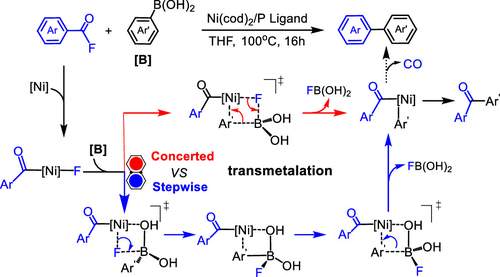当前位置:
X-MOL 学术
›
J. Org. Chem.
›
论文详情
Our official English website, www.x-mol.net, welcomes your
feedback! (Note: you will need to create a separate account there.)
Density Functional Theory Mechanistic Insight into the Base-Free Nickel-Catalyzed Suzuki-Miyaura Cross-Coupling of Acid Fluoride: Concerted versus Stepwise Transmetalation.
The Journal of Organic Chemistry ( IF 3.3 ) Pub Date : 2019-10-21 , DOI: 10.1021/acs.joc.9b02154 Chaoshen Zhang 1 , Ruihua Zhao 1 , Wasihun Menberu Dagnaw 1 , Zheyuan Liu 1 , Yu Lu 1 , Zhi-Xiang Wang 1
The Journal of Organic Chemistry ( IF 3.3 ) Pub Date : 2019-10-21 , DOI: 10.1021/acs.joc.9b02154 Chaoshen Zhang 1 , Ruihua Zhao 1 , Wasihun Menberu Dagnaw 1 , Zheyuan Liu 1 , Yu Lu 1 , Zhi-Xiang Wang 1
Affiliation

|
Density functional theory mechanistic study has been carried out to account for the base-free nickel-catalyzed Suzuki-Miyaura coupling of acid fluorides (ArC(O)F) with boronic acids (Ar'B(OH)2). After oxidative addition to break the C-F bond of acid fluoride, the resultant ArC(O)[Ni]F species undergoes transmetalation with Ar'B(OH)2 to give ArC(O)[Ni]Ar'. Subsequently, ArC(O)[Ni]Ar' can either undergo decarbonylation, finally leading to the coupling product (ArAr'), or reductive elimination to give ketone byproduct ArC(O)Ar'. The kinetic competition between the two pathways controls the chemoselectivity of the reaction, and transmetalation is the rate-determining step of the coupling. Importantly, it was found that transmetalation prefers a stepwise mechanism over a conventional concerted one. Detailed analyses indicate that the strong fluorophilicity of boron facilitates the base-free transmetalation and the coordination interaction between an oxygen atom of boronic acid and nickel gears the base-free transmetalation to undergo the stepwise pathway. The stepwise transmetalation mechanism also involves the nickel-catalyzed Suzuki-Miyaura coupling of aldehydes with ketone (PhC(O)CF3) as the transmetalation promoter.
中文翻译:

密度泛函理论对酸性氟化物的无碱镍催化的铃木-宫浦交叉偶联的机理研究:协同的与逐步的过渡金属化。
已经进行了密度泛函理论机制研究,以说明酸性氟化物(ArC(O)F)与硼酸(Ar'B(OH)2)的无碱镍催化的Suzuki-Miyaura偶联。氧化加成后,酰基氟的CF键断裂,所得ArC(O)[Ni] F物质与Ar'B(OH)2发生金属转移,生成ArC(O)[Ni] Ar'。随后,ArC(O)[Ni] Ar'可以进行脱羰基化,最终导致偶联产物(ArAr'),或通过还原消除得到酮副产物ArC(O)Ar'。两种途径之间的动力学竞争控制了反应的化学选择性,而重金属化是偶联的决定速率的步骤。重要的是,发现与传统的协调机构相比,重金属化更喜欢一种逐步的机制。详细的分析表明,硼的强亲氟性促进了无碱过渡金属化,硼酸的氧原子与镍之间的配位相互作用促进了无碱过渡金属化的逐步进行。逐步的过渡金属化机理还涉及醛与酮(PhC(O)CF3)作为过渡金属促进剂的镍催化的Suzuki-Miyaura偶联。
更新日期:2019-10-21
中文翻译:

密度泛函理论对酸性氟化物的无碱镍催化的铃木-宫浦交叉偶联的机理研究:协同的与逐步的过渡金属化。
已经进行了密度泛函理论机制研究,以说明酸性氟化物(ArC(O)F)与硼酸(Ar'B(OH)2)的无碱镍催化的Suzuki-Miyaura偶联。氧化加成后,酰基氟的CF键断裂,所得ArC(O)[Ni] F物质与Ar'B(OH)2发生金属转移,生成ArC(O)[Ni] Ar'。随后,ArC(O)[Ni] Ar'可以进行脱羰基化,最终导致偶联产物(ArAr'),或通过还原消除得到酮副产物ArC(O)Ar'。两种途径之间的动力学竞争控制了反应的化学选择性,而重金属化是偶联的决定速率的步骤。重要的是,发现与传统的协调机构相比,重金属化更喜欢一种逐步的机制。详细的分析表明,硼的强亲氟性促进了无碱过渡金属化,硼酸的氧原子与镍之间的配位相互作用促进了无碱过渡金属化的逐步进行。逐步的过渡金属化机理还涉及醛与酮(PhC(O)CF3)作为过渡金属促进剂的镍催化的Suzuki-Miyaura偶联。


















































 京公网安备 11010802027423号
京公网安备 11010802027423号